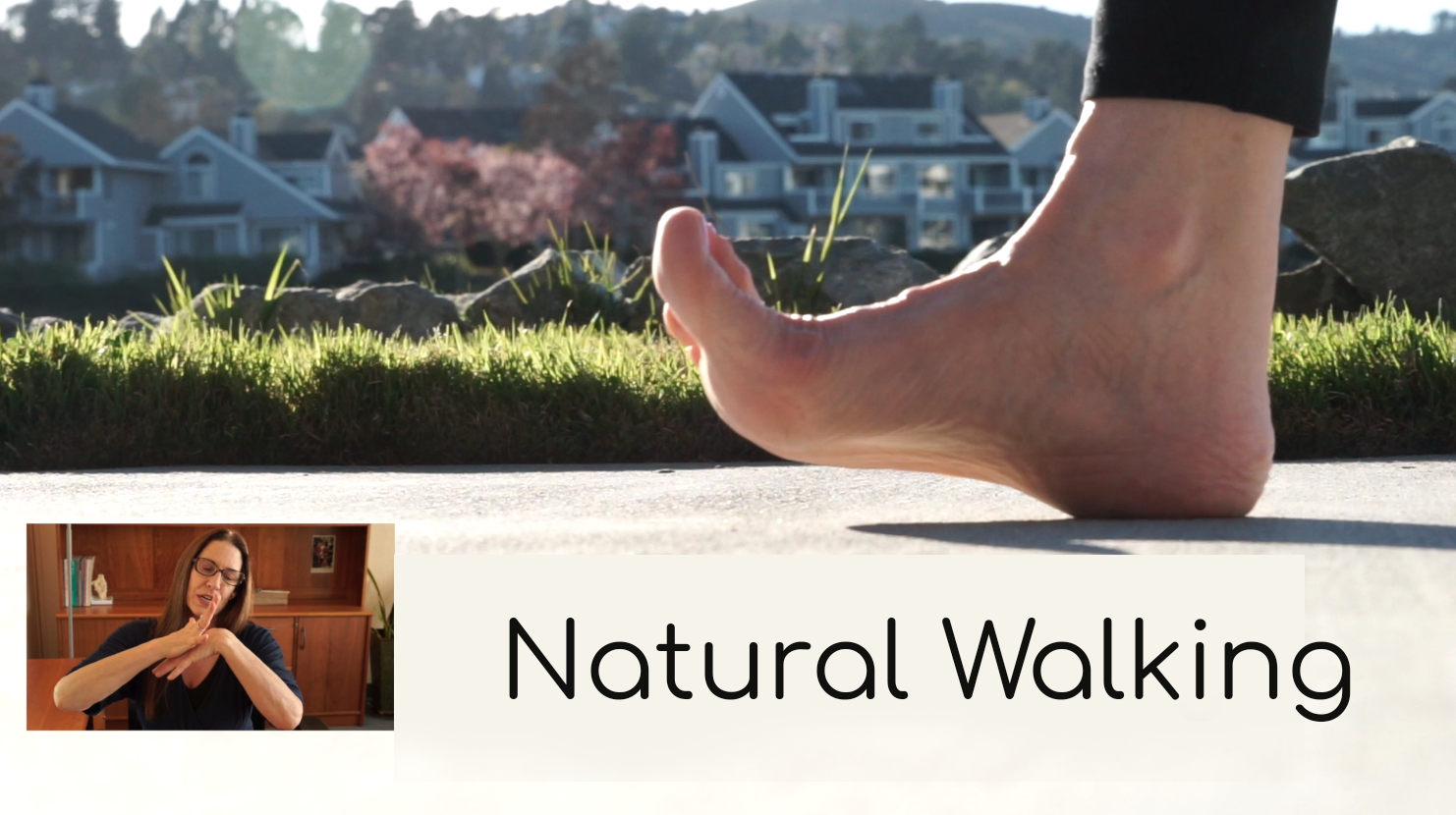Natural Walking
Natural Walking

Wouldn’t it be wonderful if you could raise your vitality, and tone, and heal your body pleasurably, all without adding any extra time to your day?
Walking the way we did as children, and the way we did in primitive times, does just that. Native walking creates profound ease, comfort and strength in our bodies.
Surprisingly, as natural and powerfully healing as native walking is, our bodies have completely forgotten how to do it!
We are meant to move through space like elegant, resonant waves. Our bodies are designed to surrender effortlessly to the coupling of gravity with the spring-like nature of our bodies. Together, these maintain a powerful, fluid connection with the Earth, which supports freedom and ease in every joint and muscle in the body.
Western conditioning, especially in the US, subliminally dissuades us from moving through space in wave motion. Sensual, embodied presence is downright un-American (I’m naming the north American convention in walking — those in the south, with their elegant, Latin swag, have it right)!
Instead of receiving the path of least resistance, our bodies move in ways that tax our joints, nervous systems and muscles, and by extension, our entire bodies. Presence, breath, and hydration are a few of the elements that restore us to flow.
Natural walking keeps the pelvis very mobile. Every joint in the spine is gently liberated, all the way up to and including the head. In fact, having infants practice pushing rhythmically with alternating feet off our hands is one way to assist them with healing cranial birth trauma.
As much as we are what we eat, we are what we do. We can literally hydrate, heal and strengthen our bodies with every step, or, with each step, we can create injury.
With the eye of a physical medicine doctor I’ve broken natural walking down into parts, and integrated the pieces. Let’s get started!
Natural walking, step-by-step:
Prepare your body for native walking by standing with your arms raised. Rock back on your heels and arch backward as far as you can without falling. This action wakes up muscles of the back of your body–the forgotten ones.
Most of us walk with muscles of the anterior (front) body, because the modern habit contracts the muscles of flexion. We overuse the anterior (front) body because the posterior (back) body goes to sleep when we sit in unconsciously in chairs.
Whether sitting or standing, the first step to returning to conscious walking is to connect to the Earth. Grounding, or “Earthing,” are terms used in limitless scientific studies that reveal the healing power of consciously engaging with the Earth.
One way to ground is to imagine you are adding a “third prong” to the electrical system of your body. Visualizing a connection, either through the soles of your feet, or down from your pelvic floor, can accomplish this. Your attention is powerful! Our bodies can’t tell the difference between real and imagined stimuli. If you can imagine it, your body will respond!
Feel your feet on the floor. Feeling your feet brings your attention down, which supports grounding. If you can touch dirt all the better. The constant, measured current running between the Earth and the Ionosphere is more powerful in nature. It’s powerful to begin to consciously participate with, or “log on” to, the river of flow. The work of Physicist Richard Feynmann illustrates this principle beautifully.
Feel your feet on the floor or dirt, and tune into the sensation of your toes. This begins to shift the nervous system toward feeling and away from thinking. A gentle grabbing motion with your toes activates the sacral plexus of nerves under your tailbone. Both actions wake up the restorative nervous system and help the body further ground and relax.
Next, attend to the opposite pole. Imagine you’re a tall, swaying, stalk of seaweed with roots deep down into the ocean floor. Imagine as your roots move down, that you are reaching for the sun above. This visualization has us begin to orient and participate in the vast circulation of current in the environment. Your body might begin to feel buoyed, and you may begin to soften and sway a bit as you yield to the sea of electromagnetic charge we float in.
Next, without gripping, contract the pelvic floor a little to awaken it. This further stimulates the sacral plexus of nerves that opposes the way we contract in response to stress. The yogic tradition names the sphincters of the pelvic floor “bandhas.” Bandha activation is a mainstay of grounding the body and recruiting its central axis of power. Awakening the pelvic floor helps us retain the energy we’re collecting in the body.
Next, feel your belly button connect with your spine. Bringing your belly button inward helps the torso begin to behave as the powerful column that it is. At times, I visualize my torso rising like a cobra from a basket, and it does!
Waking up the central axis of the body and your inner stalk of seaweed or cobra has the added effect of allowing the limbs to relax and move freely. As current begins to flow through your “midline,” your limbs will begin to allow the trunk to do the work, much like the limbs of a tree are supported by its trunk. Release your limbs and allow them to sway.
This right support relaxes, mobilizes and hydrates all of our joints, and we become stronger and more agile as our actions begin to extend from the ground. This is a very foundational principle of martial arts!
When your trunk is active and your limbs are relaxed, your hip flexors (psoas muscles) release and unbind the diaphragm at the base of your rib cage. Together with serpent motion, you’ll begin to breathe more naturally. A freely mobile trunk and breath action releases the organs in the mid-section, including the kidney (renal) and the adrenal (ad-renal) circuits of the stress response.
Lastly, allow your tongue to gently rest across the roof of your mouth. When our tongue is lifted, our swallow stimulates the soft palate at the back of your palate. This wakes up the vagal pathway of nerves (parasympathetic) that oppose the stress response. This contact is a powerful activation of midline current.
Keeping your tongue to the roof of your mouth also ensures that you’ll breathe through your nose. Nasal breathing gives us more carbon dioxide and nitric oxide, which expands blood vessels and airways and helps deliver more oxygen to your body and brain.
Are you ready to move?
Gazing in the direction you intend to move is much like driving a car while we look where we’re going. Our forward motion becomes more flowing and smooth. It’s quite powerful also to experiment with expanding your attention to include a “resonant’ amount of the space you occupy.
Now, standing long and tall with your chin gently tucked, tilt your torso forward slightly and let gravity start your movement. Leading with your hips, engage all the muscles of your legs. Really feel the muscles of your butt and thighs. Crouching a bit can help fire these muscles initially.
The arms will begin to sway easily and naturally back and forth, adding a flowing, rotational motion to the vertical wave moving up the spine. Every cell in the body is soft, strong and engaged.
Then, push off from the ball of the back foot, allowing the uncoiling of the spring of your foot and leg to propel you forward. Allow the toes in front to gently grip as if you’re pulling yourself across the ground. Imagine you’re a large cat slinking across the Serengeti!
When you land on the heel of the foot in front, roll fully through the whole arch and feel your natural “shock absorber” in action. The foot, ankle, knee, hip and pelvis are a powerful spring mechanism that effortlessly does much of the work of walking as it uncoils from the ground.
As you walk, imagine you are “dancing” with the Earth. In dance, we maintain connection with our partner by maintaining relaxed, even tension. This is an essential piece!
Feel your “tail” wag, and your butt work. “Wagging, or “swagging”, as I sometimes say, perpetuates the wave behavior through your entire body. We’re not in the US anymore!
Here in the US, our typical gait resembles defensive posturing, which can be likened to the military march. Instead of allowing gravity and our natural spring nature to do the work of walking, we actively lift our legs, which shortens the muscles of flexion, rigidifies the spine, aggravates the nervous system, and limits breathing.
Natural walking, with its flowing and relatively provocative sway, achieves the opposite. Natural walking, effortless and graceful, powerfully restores flow and power to every aspect of our being.
Natural walking takes practice, but we’re not learning anything new. We’re remembering the way we walked as children. Much like riding a bicycle, the skill does not leave us. With practice it can return quickly. If you find you’re struggling, learning with an energetically aware dance teacher can help. Tango dancing is particularly attuned to the native gait.
Natural walking is not only deeply healing, it’s also immeasurably pleasurable. Walking consciously, with just a touch of carefully wielded attention, can hydrate every cell in your body and invoke the magical combination of ease, strength and flow. Your entire body will receive healing with every step you take. I’d love to hear how it goes!




